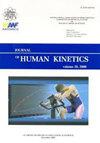半球活动启动对压力下羽毛球运动窒息的影响:三个基本技能的研究
IF 2.8
3区 医学
Q2 SPORT SCIENCES
引用次数: 0
摘要
当一个人努力表现良好,但表现却有所下降时,压力下的窒息就会发生。自我关注的方法表明,压力增加了对绩效过程的有意识关注,破坏了执行的自动或过度学习的本质。大脑半球的不对称和熟练的表现表明左半球活动减少,而右半球活动增强。先前的研究试图通过抑制左脑半球或增强右脑半球的活动来防止窒息。本研究考察了半球活动启动的增加是否可以减轻羽毛球任务中压力下的运动技能失败。这项研究涉及32名右撇子大学生,他们在启动干预下完成了五种无压力街区和窒息压力街区的条件。结果显示,从测试前到测试后,运动学习有了显著的改善,但在技能执行过程中,参与者仍然在压力下窒息。此外,启动策略(手挤压)并没有减轻压力以提高表现。该研究提供了在压力条件下表现下降的证据,并且启动策略并没有缓解窒息。本文章由计算机程序翻译,如有差异,请以英文原文为准。
The Impact of Hemispheric Activity Priming on Choking Under Pressure in Badminton Tasks: A Study of Three Fundamental Skills
Choking under pressure occurs when an individual experiences a decrease in performance despite their efforts to perform well. The self-focus approach suggests that pressure increases conscious attention on the performance process, disrupting the automatic or overlearned nature of execution. Hemispheric asymmetries in the brain and skilled performance indicate that left-hemispheric activity decreases, while right-hemispheric activity enhances. Previous studies have attempted to prevent choking by inhibiting the left hemisphere or enhancing the right hemisphere's activity. This study examined whether increased hemispheric activity priming can extenuate motor skill failure under pressure in badminton tasks. The study involved 32 right-handed college students who completed five conditions in pressure-free blocks versus choking under-pressure blocks with priming intervention. Results showed a significant improvement in motor learning from pre- to post-tests, but participants still choked under pressure during skill execution. Furthermore, the priming strategy (hand squeezing) did not alleviate the pressure to benefit performance. The study provides evidence of performance decrements under pressure conditions, and the priming strategy did not alleviate choking.
求助全文
通过发布文献求助,成功后即可免费获取论文全文。
去求助
来源期刊

Journal of Human Kinetics
医学-运动科学
CiteScore
4.80
自引率
0.00%
发文量
83
审稿时长
3 months
期刊介绍:
The Journal of Human Kinetics is an open access interdisciplinary periodical offering the latest research in the science of human movement studies. This comprehensive professional journal features articles and research notes encompassing such topic areas as: Kinesiology, Exercise Physiology and Nutrition, Sports Training and Behavioural Sciences in Sport, but especially considering elite and competitive aspects of sport.
The journal publishes original papers, invited reviews, short communications and letters to the Editors. Manuscripts submitted to the journal must contain novel data on theoretical or experimental research or on practical applications in the field of sport sciences.
The Journal of Human Kinetics is published in March, June, September and December.
We encourage scientists from around the world to submit their papers to our periodical.
 求助内容:
求助内容: 应助结果提醒方式:
应助结果提醒方式:


